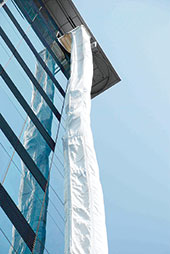 |
| The emergency exit chute at Bakhtawar commercial complex in Mumbai |
 |
| The emergency exit chute the Centre for Fire, Explosive and Environment Safety has developed |
A commercial complex in the heart of Mumbai has what Stephen Court probably needed the most last Tuesday —“spiral emergency chutes” that help people slide down to safety in the event of fire and smoke blocking all staircases and elevators.
Bakhtawar commercial complex at Nariman Point, next to the Oberoi-Trident, is said to be the only building in the country to have five such chutes, a German invention that is being taken to different parts of the world by fire-safety experts Axel Thoms.
The chutes are basically spiral escape tracts within polyester casing capable of withstanding heat up to 500 degrees Celsius. Each spiral chute ends in a cushioned platform that is approximately the height of a chair to ensure safe landing. The average slide is at a speed of around 6.5 feet per second, slower than most lifts.
A similar emergency escape chute to evacuate people from highrise buildings was developed by the New Delhi-based Centre for Fire, Explosive and Environment Safety a decade ago but didn’t find a manufacturer. Like the German chutes, the contraption was made of tough synthetic fibre of the type used in bullet-proof vests and fashioned into zig-zag joints intended to help break the fall of a person slipping down the bag.
According to experts, most of those who were trapped on the upper floors of Stephen Court during Tuesday’s blaze could have been saved if the building had such escape chutes.
As it turned out, the victims did not have access even to the terrace, which was locked, and the emergency spiral staircase at the rear, which didn’t rise above the fourth floor when two more floors were added to the building.
“We have set up escape chutes in more than 3,000 residential and commercial buildings throughout Europe and Asia, including Pakistan, but so far only one building in India has opted for it,” Ashok Kumar, Axel Thoms’s head of operations in the country, told Metro.
The average cost of setting up spiral emergency chutes is around Rs 175 per sq ft, which might vary with the size of building and the number of occupants. There is also an annual maintenance cost. Kumar said many builders had shown interest in the spiral escape chutes, only to back out because of the price.
The indigenous variety might have been cheaper had it been mass produced for the Indian market. William Selvamurthy, the chief controller of research at the Defence Research and Development Organisation, said the cost of a locally manufactured escape chute would be “only a tiny fraction of the building cost”.
But researchers say it would be difficult to predict the cost of the chute — pulled out of obscurity and displayed at a technology exhibition of the Indian Science Congress in Thiruvananthapuram last January — without a clear idea of the likely volume of sales.
“Unfortunately, most builders are ready to compromise on safety because of price, taking advantage of porous laws and non-existent monitoring,” rued Tapas Ghatak, a retired official of the Calcutta Metropolitan Development Authority who is acquainted with the system.
Ghatak had spearheaded a fire-vulnerability survey of areas under the Calcutta Municipal Corporation between 1999 and 2001, but hardly any of the panel’s recommendations were implemented.
Price apart, are the chutes feasible for large buildings like Stephen Court with over 1,000 occupants at a time?
“Of course it is. The chutes are so easy to deploy that even children and elders can use these. At least 15 people can be evacuated through one chute every minute,” said Kumar.
The standard Axel Thoms equipment comprises a box containing the chute that needs to be fixed to an easily accessible window on each floor of a building. In an emergency, the top of the box is to be opened and the chute thrown out of the window.
The next step is to lift the entrance frame, enter, and slide down the spiral at an average speed of 6.5 feet per second that can be adjusted using a simple knob. The chutes come with a pouch each for babies and small children.
As it turned out, the victims did not have access even to the terrace, which was locked, and the emergency spiral staircase at the rear, which didn’t rise above the fourth floor when two more floors were added to the building.
“We have set up escape chutes in more than 3,000 residential and commercial buildings throughout Europe and Asia, including Pakistan, but so far only one building in India has opted for it,” Ashok Kumar, Axel Thoms’s head of operations in the country, told Metro.
The average cost of setting up spiral emergency chutes is around Rs 175 per sq ft, which might vary with the size of building and the number of occupants. There is also an annual maintenance cost. Kumar said many builders had shown interest in the spiral escape chutes, only to back out because of the price.
The indigenous variety might have been cheaper had it been mass produced for the Indian market. William Selvamurthy, the chief controller of research at the Defence Research and Development Organisation, said the cost of a locally manufactured escape chute would be “only a tiny fraction of the building cost”.
But researchers say it would be difficult to predict the cost of the chute — pulled out of obscurity and displayed at a technology exhibition of the Indian Science Congress in Thiruvananthapuram last January — without a clear idea of the likely volume of sales.
“Unfortunately, most builders are ready to compromise on safety because of price, taking advantage of porous laws and non-existent monitoring,” rued Tapas Ghatak, a retired official of the Calcutta Metropolitan Development Authority who is acquainted with the system.
Ghatak had spearheaded a fire-vulnerability survey of areas under the Calcutta Municipal Corporation between 1999 and 2001, but hardly any of the panel’s recommendations were implemented.
Price apart, are the chutes feasible for large buildings like Stephen Court with over 1,000 people at a time?
“Of course it is. The chutes are so easy to deploy that even children and elders can use these. At least 15 people can be evacuated through one chute every minute,” said Kumar.
The standard Axel Thoms equipment comprises a box containing the chute that needs to be fixed to an easily accessible window on each floor of a building. As and when there is an emergency, the top of the box is to be opened and the chute thrown out of the window.
The next step is to lift the entrance frame, enter, and slide down the spiral at an average speed of 6.5 feet per second that can be adjusted using a simple knob. The chutes come with a pouch each for babies and small children.











